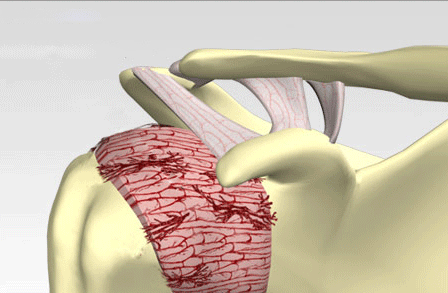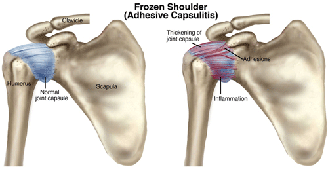Frozen Joint syndrome or Adhesive Capsulitis is a painful disorder that causes decreased (ROM) range of motion in a joint (shoulder most often, knees or less often hips). This is thought to be caused from chronic inflammation, scarring, thickening and shrinkage of the capsule that surrounds the joint. Adhesive capsulitis is often seen following periods of immobilization of the affected joint, especially after extensive surgery. Adhesions are the fibrous bands of tissue that develop between joint surfaces. A decrease in the synovial fluid, may contribute to a loss of function. The shoulder joint is a ball and socket joint with the round head of the upper arm (humerus) fits into the socket of the scapula (shoulder blade). This socket area (capsule) can thicken and tighten leaving less room for movement and can cause stiffness.
Frozen shoulder causes are unknown (idiopathic). Frozen knee most often occur after a total knee replacement surgery or recent injury. Common risk factors can include: Age > 40 years, 70% are women, following a recent surgery or fracture with immobilization, Diabetics are 2-4x more likely to develop and may have more severe symptoms, CVA, Hyper/Hypothyroidism, elevated triglycerides, CAD, Parkinson’s disease, upper extremity paresis, brachial plexus injury or spinal cord injury can be contributory causes.


Symptoms: sharp pain early then becoming more of a dull ache over time. Pain or ache is felt in the affected joint especially with movement. Pain is often located over the outer shoulder and upper arm with frozen shoulder.
Frozen joint syndrome is usually curable (may take up to 3 years) and is focused on improving range of motion and strength in the joint. NSAIDs and topical analgesics can improve pain relief. Heat and cold therapy and TENS unit are helpful. Steroid joint injections or blocks can improve inflammation and pain at the joint and may be needed prior to starting Physical Therapy. Click here for home physical therapy exercises that you can do for your frozen shoulder. XRAY or MRI may be used confirm a diagnosis or rule out other causes.
Physical Therapy includes such exercises as passive stretching and external rotation, forward flexion of arms while lying down and stretching your arm across across the front of your body.
Surgery under general anesthesia – Manipulation or Arthroscopy may be recommended if less conservative treatments fail. The surgeon will forcefully break up the adhesions and move (manipulate) the joint. This procedure is followed up with Physical Therapy after surgery to continue to improve and maintain range of motion and prevent reformation of adhesions.
This information is for educational purposes only and is NOT intended to replace the care or advice given by your physician. Always seek the advice of your physician or other qualified health provider before starting any new treatment or with any questions you may have regarding a medical condition. For more information see our Medical Disclaimer.